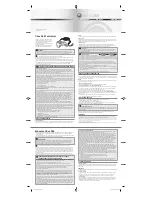
108
6250 Servo Controller User Guide
Reducing Electrical Noise
For detailed information on reducing electrical noise, refer to Appendix A.
Common Problems & Solutions
The following table presents some guidelines to help you isolate problems with your motion
control system. Some common symptoms are listed along with a list of possible causes and
remedies.
❏
Look for the symptom that most closely resembles what you are experiencing.
❏
Look through the list of possible causes so that you better understand what may be preventing
proper operation.
❏
Start from the top of the list of remedies and use the suggested procedures to isolate the
problem.
❏
Refer to other sections of the manual for more information on 6250 set up, system
connections, and feature implementation. You may also need to refer to the 6000 Series
Software Reference Guide.
Problem
Cause
Solution
Erratic operation
1. Electrical Noise
2. Improper shielding
3. Improper wiring
1. Reduce electrical noise or move the 6250 away from noise source
(refer also to Appendix A)
2. Ground Joystick Release input
3. Check wiring for opens, shorts, and mis-wired connections
LEDs:
DRIVE LED(s) is red
1. Shutdown input active
2. No AC power to drive
3. Drive not connected
1. Issue
DRIVE11
command
2. Check AC power to drive
3. Connect drive
LEDs:
STATUS LED is off
1. No AC power
1. Check AC power
LEDs:
STATUS LED is red
1. Internal Board Monitor Alarm (BMA)
has detected a non-recoverable fault
1.a. Recycle power to the 6250
1.b. 5V is not shorted to GND on the I/O connections
Missing Encoder Counts
1. Improper wiring
2. Encoder slipping
3. Encoder too hot
4. Electrical noise
5. Encoder frequency too high
1. Check wiring
2. Check and tighten encoder coupling
3. Reduce encoder temperature with heatsink, thermal insulator, etc.
4.a. Shield wiring (refer also to Appendix A)
4.b. Use encoder with differential outputs
5. Peak encoder frequency must be below 1.2 MHz post-quadrature;
peak frequency must account for velocity ripple
Motor does not move in
joystick mode
1. Joystick Release input not grounded
2. Improper wiring
1. Ground Joystick Release input
2. Check wiring for opens, shorts, and mis-wired connections
Motor Runaway
(if encoder counts positive
when turned clockwise)
1. Direction connections reversed
1. Switch CMD- with the CMD+ connection to drive
No Motion
1. Status LED off or red
2. Limits engaged
3. Drive fault level incorrect
4. Improper wiring
5. Load is jammed
6. No torque from motor
7. Maximum position error exceeded
8. Drive has activated the Drive fault
input
9. ENBL input is not grounded to GND
1. See status LED problems above
2. Move load off of limits or disable limits with
LHØ,Ø
2.b. If using soft limits, make sure
LSCW
>
LSCCW
3. Set drive fault level using
DRFLVLxx
(for S, Z, and K drives, use
DRFLVL11
)
4. Check command, shutdown, drive fault, & limit connections
5. Remove power and clear jam
6. See problem:
No Torque
7. Issue the
DRIVE1
command to the axis that exceeded the position
error limit
8.a. Check to see if
TAS
bit #14 is set, and check the
DRFLVL
command
to ensure the drive fault level is correct
8.b. Inspect the drive to determine the cause
9. Ground the ENBL input to GND and reset
No RS-232C
Communication
1. Improper RS-232C Interface or
communication parameters
2. RS-232C disabled
3. In daisy chain, unit may not be set to
proper address
1. See
RS-232C Troubleshooting section
2. Enable RS-232C with the E command (all units if daisy-chained)
3. Verify DIP switch settings (see
Optional DIP Switch Settings in
Chapter 8), verify proper application of the
ADDR
command
No Torque
1. Improper wiring
2. No power to drive
3. Drive failed
4. Drive faulted
5. Drive shutdown
1. Check wiring to drive enable input on drive as well as other system
wiring
2. Check power to drive
3. Check drive status
4. Check drive status
5. Enable drive with
DRIVE11
Power-up Program does
not execute
1. ENBL input is not grounded to GND
2.
STARTP
program is not defined
1. Ground the ENBL input to GND and reset
2. Check the response to the
STARTP
command. If no program is
reported, define the
STARTP
program and reset
Program execution: stops
at the
INFEN1
command
1.
INFEN1
enables drive fault
monitoring, but the drive fault level
(
DRFLVL
) command is set incorrectly
for the drive being used.
1. Issue the correct
DRFLVL
command for your drive (refer to the
DRFLVL
command)
















































